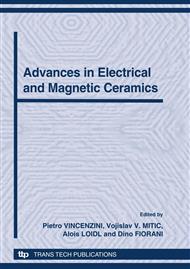p.108
p.113
p.118
p.124
p.134
p.143
p.149
p.158
p.164
Electrical Properties of Nb-Doped and Nb-Mn-Codoped BaTiO3-(Bi0.5Na0.5)TiO3 Lead-Free PTCR Ceramics
Abstract:
Nb-doped and Nb-Mn-codoped (1-xmol%)BaTiO3-xmol%(Bi0.5Na0.5)TiO3 (BBNTx) lead-free positive temperature coefficient of resistivity (PTCR) ceramics were prepared by the conventional solid state reaction method. The XRD patterns indicated that all BBNTx samples formed a single perovskite structure with tetragonal phase. 0.25 mol% Nb doped BBNT1 ceramic, sintered at 1330°C for 1h in air, had low room-temperature resistivity (ρ25) of 80 Ω•cm and a high resistivity jump (maximum resistivity [ρmax]/minimum resistivity [ρmin]) of 4.2 orders of magnitude with Tc about 152°C. The Nb-doped BBNTx (10≤x≤60) ceramics also showed distinct PTC effect with Tc between 185 and 232°C by sintering in N2, which was shut off when samples were cooled to a low temperature. In addition, The Nb-Mn-codoped BBNT1 ceramics exhibited higher resistivity jump than the single Nb-doped ones, with increasing the room-temperature resistivity.
Info:
Periodical:
Pages:
134-142
Citation:
Online since:
October 2010
Authors:
Keywords:
Price:
Сopyright:
© 2010 Trans Tech Publications Ltd. All Rights Reserved
Share:
Citation:


